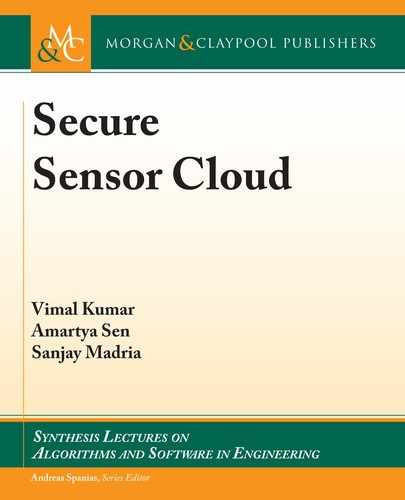42 3. SENSOR CLOUD ARCHITECTURE AND IMPLEMENTATION
WSNs. Once all WSNs providing data to selected VSNs in the hierarchy are switched on the
backend application server starts relaying data which is parsed according to the VSN hierarchy.
We consider tree topology of WSNs to represent cloud of sensor networks, internally
aggregated data from WSN would be represented as the data for a specific virtual sensor. ese
virtual sensors will be representing the geographical region(s) selected by a user. Figure 3.6 shows
the hierarchy of the network where each leaf level node represents a WSN and other nodes
represent regions. e order of data aggregation for a virtual sensor node depends on its position
in the tree topology.
Architecture of virtual sensors is displayed in Figure 3.6. When user needs data from a
region which is a collection of multiple WSNs, the middleware acknowledges the requests and
forwards activation message to associated base station servers. Base stations behave in the same
manner as explained in multi-user environment, however, because multiple WSNs are involved
in this case, data from these WSNs are aggregated and displayed to the user as per their request,
i.e., selected sensing phenomena and sampling time frequency and duration. Middleware takes
up the responsibility to aggregate data by making a data request to the multiple WSNs that
are involved in such scenarios. e advantage of this approach is evident by the fact that it
provides location transparency to users by hiding minute details about the physical locations of
the sensors, while dispensing their service requests.
3.5.6 TIME MODEL FOR VIRTUAL SENSORS
Consider two WSNs, WSN
1
and WSN
2
, sensing and sending data to the middleware through
backend applications. User
1
needs aggregated data from WSN
1
and WSN
2
at a time interval
of 15 min; and User
2
needs data from WSN
2
at 10 min time interval. In this case, physically
WSN
1
will sense data at frequency 15 min because WSN
1
has to serve only one user at a time
interval of 15 min. On the other hand, for WSN
2
there are two requests from User
1
and User
2
at time intervals of 15 and 10 min, respectively. Hence, WSN
2
will sense data at the minimum
frequency among all the requests (minimum interval between 10 min and 15 min is 10 min).
While displaying data to the User1, latest data from WSN
1
and WSN
2
, at the interval of 15 min
will be aggregated and shown. So User
1
will be displayed the aggregated data from WSN
1
and
WSN
2
every 15 min, irrespective of the fact that WSN
2
is sensing data at the 10-min interval.
Although WSNs are physically sensing data at different intervals, the end user receives the data
at the interval that they have selected. We refer to this scenario as virtualization. e end user
is transparent to the frequencies at which WSNs are running. With the compromise of some
accuracy, the sensor cloud is capable of provisioning data for more than one user at the same
instance of time. Figure 3.7 shows the Time model for the sensor cloud [27].
3.6 SUMMARY
Sensor clouds aim to take the burden of deploying and managing the network away from users
by acting as a mediator between the users and the WSNs and providing sensing as a service. In

3.6. SUMMARY 43
Wireless
Sensor
Data
Wireless
Sensor
Data
Stream Data
30 lumen
23 lumen
30 lumen
Local Time
Stamp
2.00 pm
2.15 pm
2.30 pm
Stream Data
32 lumen
25 lumen
33 lumen
Local Time
Stamp
2.00 pm
2.15 pm
2.30 pm
Stream Data
34 lumen
27 lumen
20 lumen
36 lumen
Loc
al Time
Stamp
2.00 pm
2.10 pm
2.20 pm
2.30 pm
Stream Data
34 lumen
27 lumen
20 lumen
36 lumen
Local Time
Stamp
2.00 pm
2.10 pm
2.20 pm
2.30 pm
Requested Time
Interval
(15 mins)
Database
Requested Time
Interval
(10 mins)
Figure 3.7: Time model for sensor cloud.
this chapter, we described the layered architecture of the sensor cloud system both on a con-
ceptual and physical level which allows sensor networks spread in wide geographical areas to be
connected and used as a single entity. It further allows the usage of sensor networks by multi-
ple users at the same time by virtualizing the resources in software. Virtualization also helps in
creating what we term as derived sensors from heterogeneous data streams.
..................Content has been hidden....................
You can't read the all page of ebook, please click here login for view all page.
